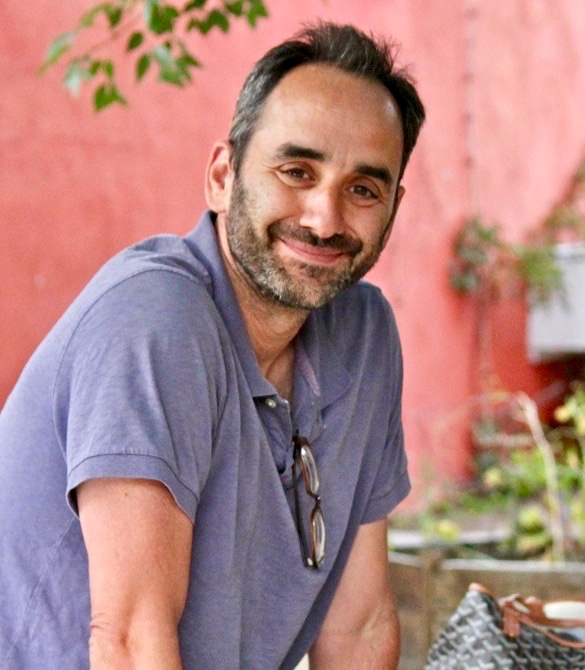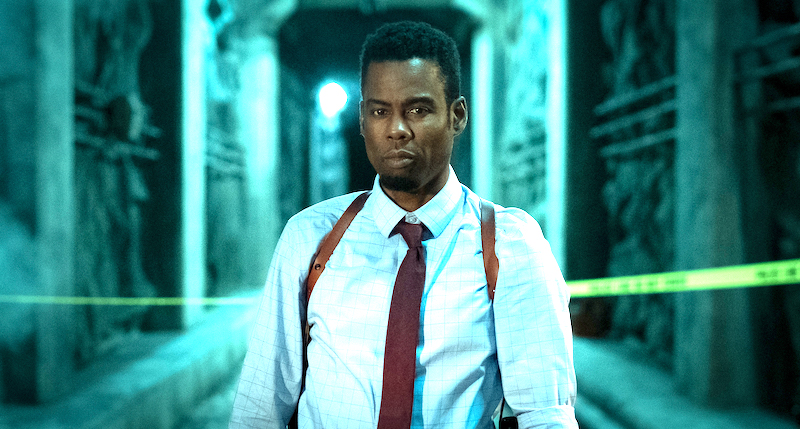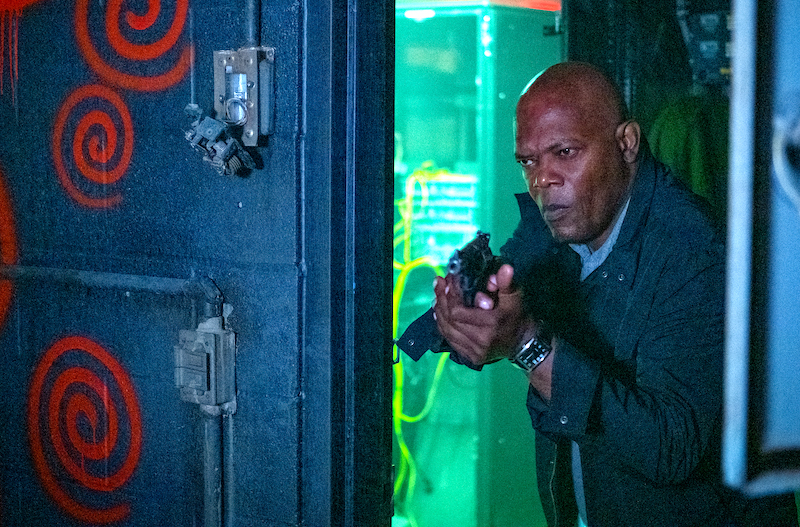Spiral: From The Book Of Saw is the ninth installment of the blood-curdling Saw franchise first brought to our screens by two newbie Australian filmmakers Leigh Whannell and James Wan. They had a simple thematic spine which drove the franchise – respect your life or it will be taken from you. We spoke with the writers of Spiral on how they honored and built on the preceding films to breathe fresh life into the franchise. “We had to satisfy the existing fans and those that were new to the Saw world,” explained Goldfinger.
The writing duo are no stranger to the Saw franchise. They co-wrote Jigsaw in 2017, complete with the gruesome killings audience expect in every Saw movie. The twist – they are reminiscent of John Kramer (aka Jigsaw) who died ten years earlier.
Goldfinger and Stolberg began plotting Spiral from a unique position – as a sequel to Jigsaw (2017) rather than as a sequel to the original Saw (2004). “You’re not quite as beholden to the mystery and backstory of Jigsaw. Fans who know the world and those new to the word don’t need to have too much explained to them to follow it.” Spiral can be enjoyed by audiences without any awareness of the Saw franchise as a standalone film. Paying too much homage to all its predecessors is in danger of collapsing under Saw’s history. It’s not important if Jigsaw is still alive or not.
Despite Spiral being ostensibly the second movie in the Jigsaw franchise, the writers had to give the fan base who love the history enough material in a world where Jigsaw still exists.
Josh Stolberg has no interest in rebooting the Saw franchise or remaking the original film. “This world is already beautifully developed. It’s a fresh spin on a very familiar world.”

Josh Stolberg. Photo by Jenni Blong
Despite innovating and branching out the story universe, Goldfinger and Stolberg have carefully studied all the Saw films without fear of having their cinematic vision tainted by history. “We did a deep dive so we didn’t fall victim to repeating things,” said Stolberg. “There might even be a loose end or unused story element that could re-ignite our creativity,” added Goldfinger.
Structurally, Saw movies don’t follow the three-act structure in the traditional sense. “A Saw film has six mid points – the story dramatically changes direction every ten pages,” he continued.
Thematic Evolution
As the Saw franchise evolves, so too does its thematic terrain. Jigsaw allowed the screenwriters to explore John Kramer character in terms of why he became who he was. His absence from Spiral gave them the freedom to mine his character beyond his personal world. It also gave them the space to explore more current themes such as cheating death.
Jigsaw’s underlying motivation was to punish people who don’t appreciate their lives. “They will either die or appreciate their lives on the other side of their ordeal,” expounded Goldfinger. This is the engine that drives the movie franchise. “The question then is, ‘are there other philosophies that lead to similar consequences?‘”
It’s easy to churn out another Saw chapter every few years as a safe option. Producers Oren Koules and Mark Burg have been on board since the first Saw film and have an encyclopedic knowledge of the world. Fortunately, they are overly protective of it and will not simply release a sequel for the sake of it.
“A bunch of other writers came in to pitch ideas, but none of them broke though. We pitched different ideas for two and a half years until Koules and Burg approved of our take on Spiral,” added Goldfinger. “There are many producers involved and they all have to sign off.”
“During those two and half years, we pitched eight different versions of Spiral as we were trying to find the story. It was really refreshing having so many people come to the table who are so passionate about the work,” Stolberg chimed in. “Our ideas had to pass the sniff test between eight to ten people.”

Peter Goldfinger
A unique element of the pitching process was that producers weren’t interested in the death traps most frequently associated with the film. “When we have the story set up, we can talk about the traps,” said Goldfinger. “It forces you not to use the violence as a crutch for the story. A successful film isn’t about how cool your death scenes are, but about the plot and characters,” continued Stolberg.
The hallmark of every Saw movie is the big plot twist. The audience expects it at some point, and Goldfinger and Stolberg delivered. “The audience is looking for it every step of the way. It’s a magic trick trying to figure out how to put cool enough things in front of the audience so the twist doesn’t come as a complete surprise, but satisfies them at the reveal – like a magician flashing the card the audience member chose,” added Stolberg.
Chris Rock Onboard
Chris Rock (Detective Zeke Banks) allegedly pitched a sequel idea to Lionsgate before it was merged with Goldfinger and Stolberg’s. Goldfinger recalls the origins of Beverly Hills Cop in which Sylvester Stallone was starring. Three weeks before shooting, Stallone dropped out and Eddie Murphy was cast as Axel Foley – and the action, buddy, comedy genre took root. Similarly, Chris Rock best known as a comedian wanted to flex his comedic muscles in Spiral. He didn’t want to see a joke in the outline or script. “If a joke is needed, I [Eddie] will take care of it,” said Peter.
“Peter and I were pretty far along with another Saw script when Chris’ idea became the basis for Spiral.” Chris Rock is a long time horror and Saw fan and pitched Lionsgate really hard to be involved. “What if I’m [Zeke Banks] the guy that’s tied to a pipe and given a hacksaw? What would I do?” said Josh of Chris Rock’s meeting. “This ignited the creativity of the studio and that’s when we started discussing ideas with Chris.” This raised some concerns, not only about how the film would turn out, but how the audience would respond to a comedian in a horror movie.
Saw has been entertaining audiences for over sixteen years, so a natural conclusion to the franchise may exist at some point. “Franchises start to fall apart when filmmakers try to do the same thing over again. It’s like addiction. The same pill produces diminishing results until it has no effect,” said Stolberg. “The thing that makes sequels great is when they take chances and go in different directions. We’ve taken a big swing in telling a brand new story within the franchise in Spiral.”
Different stories aren’t always about changing characters. “They are about changing the look of the film and changing themes, while maintaining the signature traps and intense violence.”

Zeke Banks (Chris Rock)
The writers relish the time when they see how the Saw franchise might evolve in decades time.
It’s easy for screenwriters and filmmakers alike to get caught up in the visuals of the horror franchise. It’s imperative for writers to pay due deference to the morality of any story they tell to enhance its cross-audience appeal. “In Saw’s case, it’s the reminder that your life should mean something,” according to Goldfinger. “Take note of how short life is regardless of how you feel.” This simple message resonates with people of all ages. Older viewers might be reminded that there’s still time to do things before they pass. “It isn’t simply middle-aged men or teen-aged boys becoming excited by the violence even though it is earned. Woman are also huge fans of the horror genre,” said Goldfinger.
The thrill of horror movies is as intense as cinema itself. “It’s a rollercoaster ride,” added Stolberg. “It’s like jumping out of an airplane. It’s the idea that you’re cheating death. It’s the mental anguish. Then the parachute opens and you come out the other side alive. It’s exhilarating. You land on the ground and go back up again.” This is a curious sentiment given that Stolberg claims that the sight of blood makes him pass out.
Goldfinger believes that horror films serve a higher social purpose than sheer entertainment. People don’t feel as alone knowing that other people can get through traumatic events and emerge as wiser human beings. It helps people who have these crazy, violent thoughts to cope with the world around them. It’s okay to have these thoughts. Just don’t act on them.
